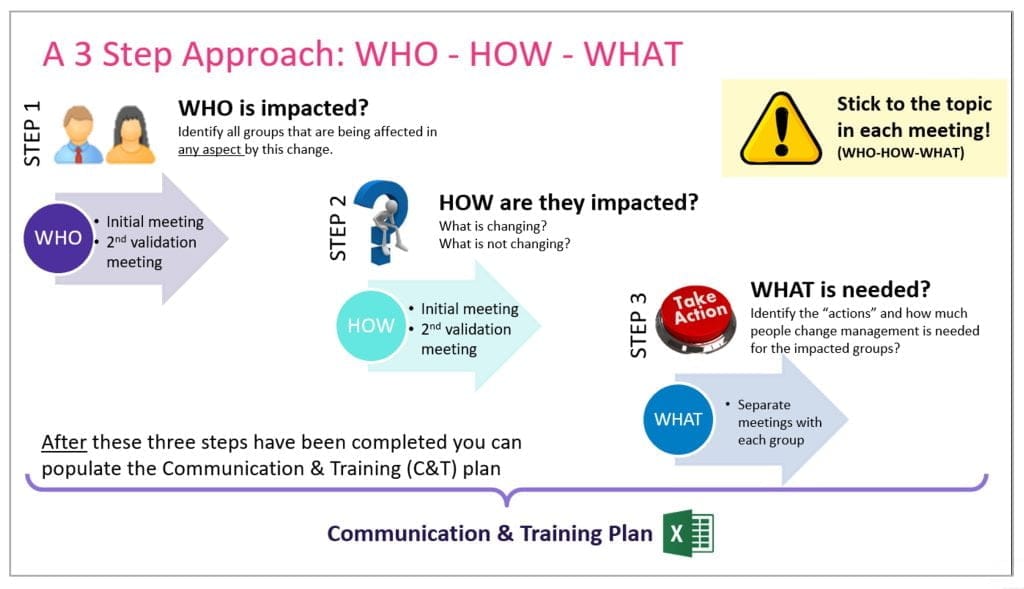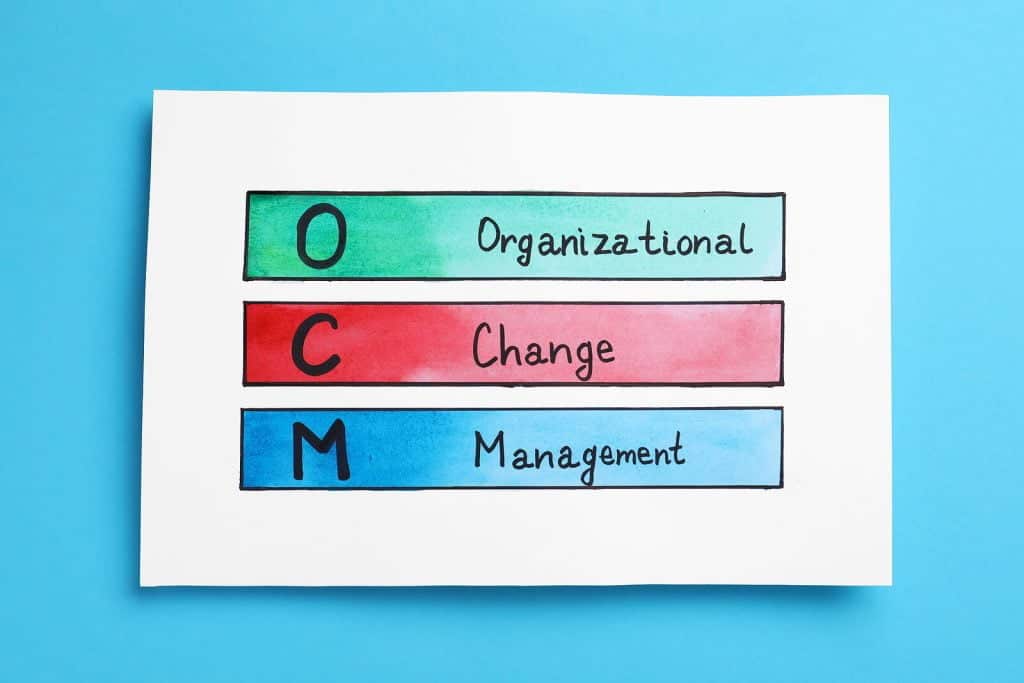Abstract
Many projects, and especially IT projects, often struggle to deliver the expected outcome. A critical factor hindering project success is that the people affected by the change are reluctant to alter “the way they work,” or embrace the new process, technology, or organization.
Table of Contents
ToggleOrganizational Change Management (OCM), frequently called “People Change Management,” drives the required change within an organization. For smaller projects, there are often no dedicated OCM resources with the required skills that can support the change initiative.
As a project manager or project team member, you can use this simple approach that I have developed to identify who is impacted, how they are impacted, and what tasks and actions are required to affect the change.
This method is called “The WHO-HOW-WHAT Approach” and is simple and straightforward to execute.
This article will provide you the techniques and tools in order to use “The WHO-HOW-WHAT Approach”, however, these techniques should not be seen as the complete solution to OCM activities, but rather as the first step in the process of helping an organization and its people through a change initiative.
There are multiple comprehensive industry People Change Management frameworks that could be considered when introducing large scale change projects e.g., John P. Kotter’s 8 steps or ADKAR from Prosci.
Why are we focusing on Organizational Change Management?
The question may be asked, “Why should we execute OCM activities?” Having a quick, compelling answer ready could help get funding or resources to execute a more comprehensive OCM program.
Here is the answer to this question: To increase the probability of the project being successful.
How does Organizational Change Management contribute to the project being successful?
There are four areas where OCM helps with increasing the success of a project.
- First, it will identify and mitigate resistance to the change.
- Second, it will improve the speed of adoption of the changes: in other words, how quickly people will begin using the new processes and technology.
- Third, it will increase the utilization which means that more people will use the delivered solution and processes from the start.
- Fourth, it will optimize the proficiency of how people are using the new technology and processes which minimizes costly mistakes and process failures.
So, with less resistance to the change, quicker adoption and embracement, more people using the systems and tools more wisely and efficiently – this will substantially increase the probability of a project’s success to deliver expected project outcome.

Organizational Change Management – The WHO-HOW-WHAT Approach
Clear and frequent communication, FAQs, system demonstration, helpful training, and other change-related activities are critical aspects to increase the probability of delivering a successful project.
The WHO-HOW-WHAT Approach will provide a simple and structured method when creating a Communications and Training Plan to identify WHO is impacted, HOW they are impacted and WHAT activities are required.
In a nutshell, the overall execution of The WHO-HOW-WHAT Approach should take about three to five weeks for a small or medium sized project.
The key is to start NOW, don’t wait until the project is well under way or when the process/technology/organization is ready for deployment. Start with this approach as soon as the project is initiated. Remember, the Communication and Training Plan is a living document and will be updated during the project with activities identified during project execution.
Week one is all about identifying WHO is impacted by the project. Week two focuses on HOW they are impacted. Week three, and beyond, dictates WHAT activities are required.
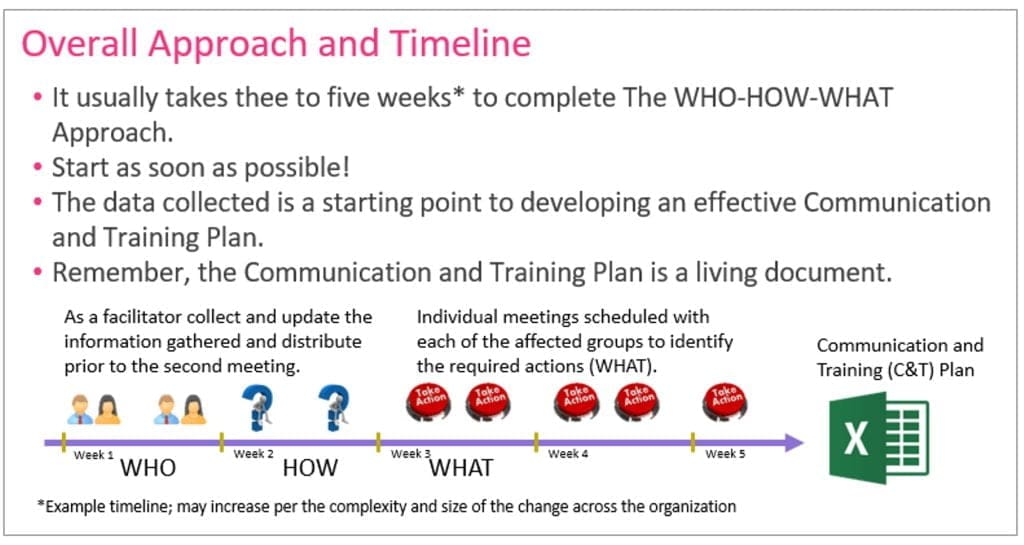
There are three distinct steps involved when executing The WHO-HOW-WHAT Approach.
Step 1 – WHO
Schedule an initial meeting, and invite the participants based on an assessment of which groups are affected by this change. One person from each group should be enough to represent that group. Identified groups could be, for example, the service desk, technical groups, finance, IT management, business groups etc.
Further groups will be identified by the participants of this meeting. During the second meeting, the newly identified groups will confirm the additional groups. This list will expand during the execution of the project.
The outcome of Step 1 will be a list of groups (Who) and a short description of each. Stick to the agenda – Identification of which groups are impacted!

Step 2 – HOW
In week two, conduct the HOW meetings. Usually, two meetings with all participants should be sufficient to gather enough information on how they are impacted.
Will the change completely disrupt the way the group is working, or is the group minimally impacted? Are there new processes, technology, procedures, policies, organizational structures, reports etc. that affect the impacted groups?
Ask the following questions in the meeting to start a conversation and to help with identifying HOW they will be impacted.
- What is changing / not changing?
- What is driving the change, and why are we changing?
- WIIFM? (Most likely different for each of the groups)
- Who is going to lose or gain / and what?
The outcome from Step 2 will be a description of how each group is impacted by the project. The information should capture the major changes and impact on the group.
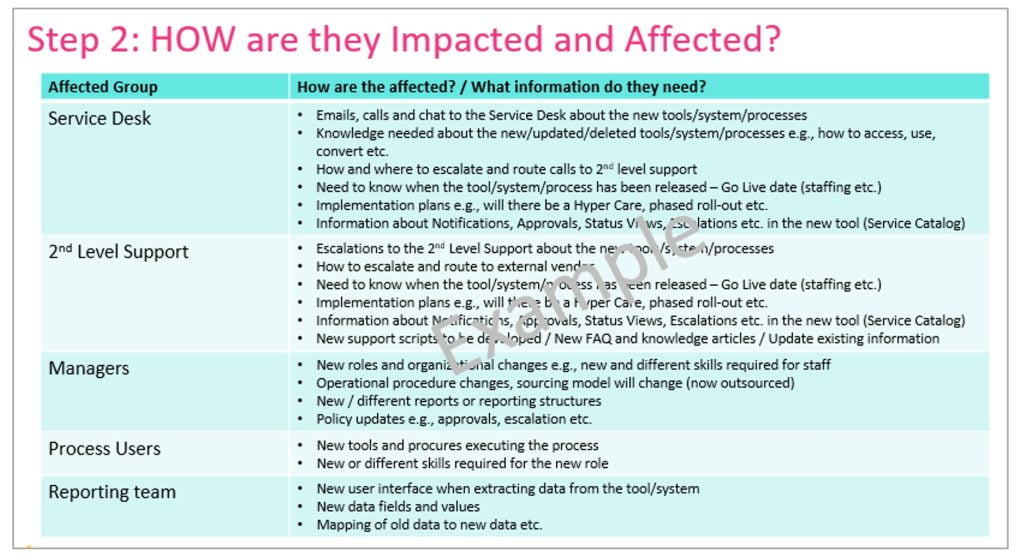
Starting in week three, conduct separate meetings with each of the identified groups to get a better understanding of WHAT activities are required for this specific group. As these meetings are separate, it might take a few weeks to get this step completed.
The outcome of Step 3 is a more detailed description of each group’s required activities and is captured on their individual PPT slide.
During this meeting, identify the optimal time for the various activities to take place as well as who will be accountable for developing the material.
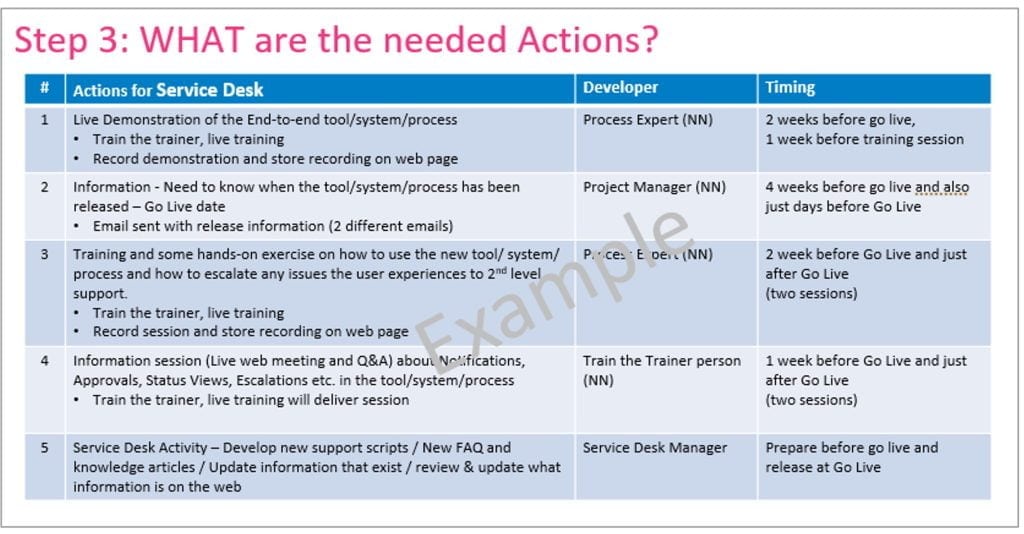
Communication and Training Plan
After capturing all the data from the meetings, the WHO, HOW and WHAT, it is time to start developing the Communication and Training Plan.
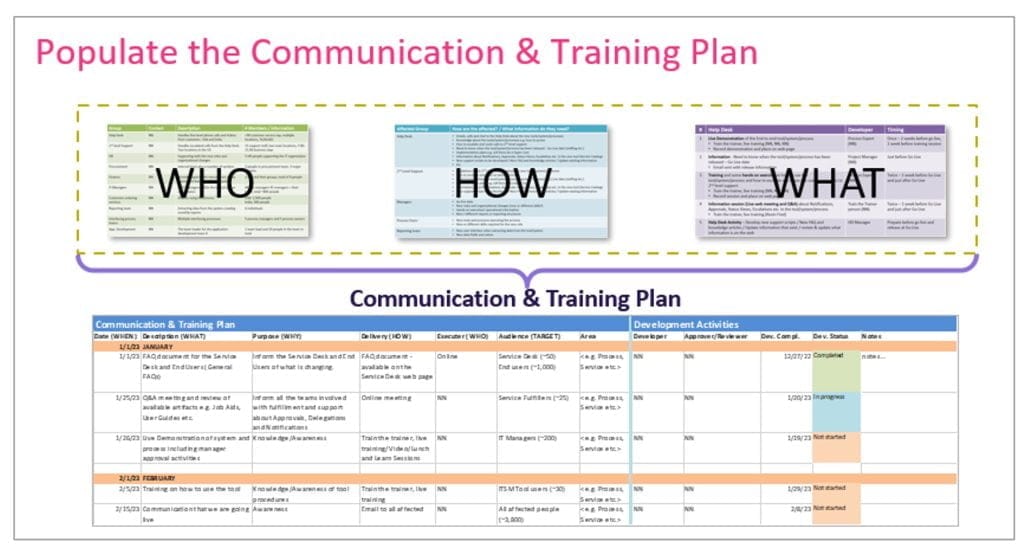
Don’t start populating the Communication and Training Plan template until there is enough data captured, AFTER the three steps.
A common error made during the WHO and HOW meeting is participants attempting to identify the WHAT. In order to remain on track, stay focused.
The Communications and Training Plan is a living document that will be continuously updated during the project. It will also serve as a record of all activities performed and can be used as a guide to check if enough OCM activities have been performed for a specific group or area.
Summary and Templates
As previously stated, this is a very simple method to identify WHO is impacted, HOW they are impacted and WHAT activities are required. It is like a stakeholder analysis but simplified as well as a starting point for an OCM journey. It, however, should not be seen as a comprehensive OCM methodology.
